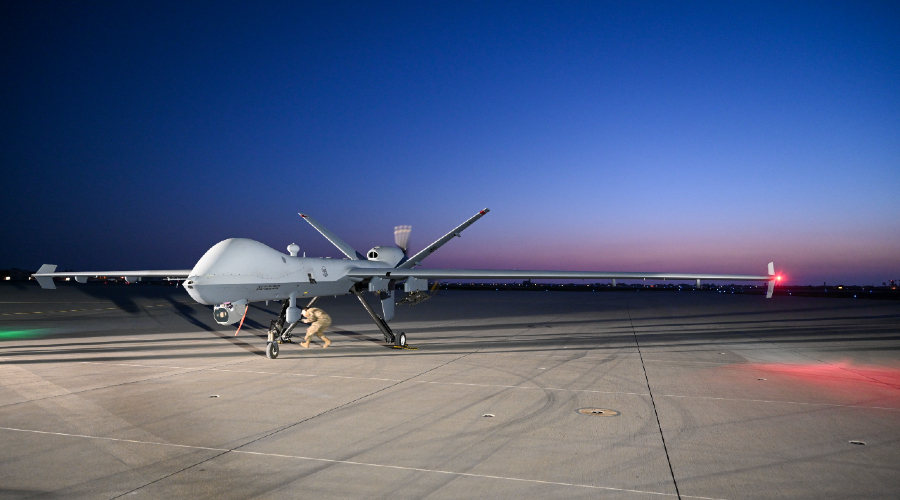Over-the-Horizon Does Not Have to Mean Next Door
The United States has a range of options for its new Afghanistan policy.

Published by The Lawfare Institute
in Cooperation With

Editor’s Note: U.S. forces have left Afghanistan, and the Biden administration is now relying on an “over-the-horizon” approach to manage any terrorist problems that persist. The Center for a New American Security’s Stacie Pettyjohn examines the different over-the-horizon options for the U.S. military, assessing their strengths and limits.
Daniel Byman
***
The United States is shifting to an over-the-horizon presence to prevent Afghanistan from once again becoming a terrorist safe haven, but there is a range of options for what that might entail. In July, President Biden stated that the United States would develop “a counterterrorism over-the-horizon capability that will allow us to keep our eyes firmly fixed on any direct threats to the United States in [Afghanistan], and act quickly and decisively if needed.” The Pentagon is not going to be able to hunt terrorists as effectively as it did when it had boots on the ground and an extensive intelligence network in Afghanistan. Yet American drones can apply significant pressure on terrorist groups, limiting their ability to attack the U.S. homeland. Relying primarily on drones operating from Central Asian or Persian Gulf bases offers an effective and economical way of containing terrorists, but it does require access to third-party airspace and air bases.
The Defense Department’s preferred approach to counterterrorism operations uses a limited number of U.S. special operations forces and advisers to integrate American airpower with capable partner ground forces. In Iraq and Syria, for instance, anywhere between approximately 300 and 4,500 U.S. ground troops advised and assisted Iraqi and Syrian forces that were responsible for leading the fight on the ground against the Islamic State. Because of the U.S. military withdrawal and the collapse of the Afghan military, this medium-footprint approach that destroyed the Islamic State’s so-called caliphate in Iraq and Syria is not possible in Afghanistan. With this option foreclosed, the Pentagon is left relying on airpower exclusively. Three remaining over-the-horizon options for Afghanistan counterterrorism operations include securing access to nearby air bases in Central Asia, flying from a U.S. aircraft carrier, and relying on bases in the Persian Gulf. Each alternative has strengths and weaknesses, but ultimately drones operating from nearby or distant bases offer a cost-effective way of weakening terrorist groups in Afghanistan and protecting the United States.
The first option is a just-over-the-horizon approach where U.S. aircraft operate from air bases adjacent to Afghanistan. Just-over-the-horizon counterterrorism operations are the Pentagon’s favored approach when a government is too weak to cooperate effectively, or is unwilling to work with the United States to combat terrorists on its territory, and lacks air defenses that can threaten U.S. aircraft. Armed drones, like the MQ-9 Reaper, patrol the skies monitoring terrorist activity but also occasionally launching strikes to kill senior terrorist leaders or to disrupt their operations. Proximity is important because it allows aircraft to continuously keep watch with relatively few forces and to be more responsive to emergent targets. Because they are uncrewed, drones can remain on station for a long time and are also equipped with an array of sensors, including full-motion video, which help to identify and track terrorists who are trying to blend in with civilians. Special forces nonstandard surveillance aircraft, like the U-28A Draco, are crewed and thus limited by duty-period limits and are not armed, but they offer a low-visibility way of collecting intelligence when close bases are available.
For Afghanistan this means that U.S. aircraft need base access in one of the former Soviet Central Asian republics or in Pakistan. Both Uzbekistan and Kyrgyzstan previously hosted U.S. forces, and Uzbekistan may be interested in renewing this relationship. Russian President Vladimir Putin also reportedly offered Russian bases in Kyrgyzstan and Tajikistan for U.S. intelligence operations. Thus far, however, the United States has not secured basing rights from Russia or its former republics, and Pakistan seems unlikely to welcome U.S. aircraft. Yet to maintain good relations with Washington, Islamabad may be willing to keep open what Gen. Frank McKenzie, the commander of U.S. Central Command, called the “air boulevard” through western Pakistan to Afghanistan. Free passage through Pakistani airspace is necessary for the other two over-the-horizon options.
If nearby base access is not forthcoming, some observers have suggested that a sea-based over-the-horizon presence with U.S. aircraft flying from carriers in the Arabian Sea is the next best option. U.S. aircraft carriers were vital in the opening phase of Operation Enduring Freedom—the war in Afghanistan—when Washington could not secure close bases. On occasion, sea-based aircraft may be needed to temporarily supplement or substitute for land-based aircraft, but given their relatively short ranges, they would require extensive support from U.S. Air Force tankers and thus are ill suited for long-duration armed overwatch missions. Moreover, employing aircraft carriers for steady-state counterterrorism operations is expensive and limits their availability for other missions. Less time on station means that more aircraft are needed to maintain the same amount of coverage of an area. The U.S. Navy has only 11 aircraft carriers, and the carrier fleet’s readiness has suffered due to frequent deployments to the Middle East. The Navy would need to dedicate at least three carriers to keep one carrier continuously on station for overwatch operations over Afghanistan. This would be an expensive approach that ties up a large portion of the U.S. carrier fleet for a persistent, relatively low-priority threat and diverts resources from China, the Pentagon’s foremost rival. During the summer of 2021, the USS Ronald Reagan carrier strike group, which is based in Japan, deployed to the Middle East to support the withdrawal of U.S. forces from Afghanistan, leaving the Indo-Pacific region without a U.S. carrier presence. Critics denounced this move as it signaled to allies and adversaries a lack of U.S. commitment and an inability of the Defense Department to follow through on its pledge to prioritize the Indo-Pacific region.
The third option of a distant over-the-horizon presence would use bases in the Persian Gulf to support counterterrorism operations over Afghanistan. Contrary to what some critics claim, while basing aircraft farther away from Afghanistan is not ideal, it is possible to conduct effective limited counterterrorism operations from this distance. Because they do not have pilots on board, drones have great persistence and are in many ways well suited for this mission, which involves long transit flights from Qatar or the United Arab Emirates to Afghanistan and then flying circles in the sky while collecting imagery and signals intelligence of suspected terrorist activity. Even when transit time to and from the operating area is factored in, U.S. drones flying from the Gulf can stay over Afghanistan for more than 10 hours without needing to be refueled. Moreover, the Air Force does not consider the current generation of drones relevant for high-intensity conflict, so the department would not be putting mileage on aircraft needed for higher-priority threats.
Secretary of Defense Lloyd Austin has stated that the Defense Department is looking to establish additional base access to “shorten the legs” of flights to Afghanistan. Central Asian basing would be the most efficient, but it is not necessary and Washington should not pursue this option at any cost. Prior basing agreements in Uzbekistan and Kyrgyzstan were expensive as both Tashkent and Bishkek demanded large payments and ultimately proved to be unreliable hosts. Even while both nations have new leaders, if U.S. basing rights are viewed transactionally these dynamics would likely resurface. This is particularly likely if Moscow also tries to spoil the host nation’s relationship with the United States.
Airpower of any type and based in any location is not going to solve the problem of terrorism in Afghanistan. As the past 20 years demonstrated, even with U.S. boots on the ground, the United States could not obtain this goal. But it is clear that the Biden administration has more circumscribed goals and that—when rooted in a larger counterterrorism strategy that includes intelligence sharing, diplomacy, economic sanctions and counterterrorist financing—over-the-horizon drone operations can disrupt terrorist networks and protect the United States from international terrorist attacks.
Over-the-horizon counterterrorism operations apply pressure on organizations like al-Qaeda and the Islamic State in Khorasan province and make it difficult for these groups to safely plan, recruit and train. Close surveillance can force terrorists to operate in a more covert and distributed manner as massing forces to train or seize territory would be risky. It also inhibits their communications and could ultimately force them to prioritize survival over planning large-scale attacks against the United States. In any over-the-horizon option, U.S. aircraft should use force sparingly and only when lucrative and verified terrorist targets present themselves. Periodic strikes against a group’s leadership can keep a group off balance by creating personnel turnover and generally thinning out an organization’s ranks of skilled personnel. The absence of an extensive human intelligence network on the ground in Afghanistan will limit the number of cues or tips and hamper air operations, but it will not render them ineffective. The U.S. military needs to recognize that the circumstances today differ from the past two decades and accept that it must adapt. Counterterrorism is not the United States’ top priority, and fewer resources will be available to support this mission. This does increase the risk of errors, like the tragic Aug. 29 airstrike in Kabul that killed 10 civilians. To protect civilian lives, the United States will need to strictly limit when force is authorized, but mistakes will inevitably occur because of the limited intelligence available. Nevertheless, if terrorists know that armed U.S. drones are likely loitering above watching and listening, the mere presence of these aircraft may constrain their behavior.
In the end, military pressure is only one element of a broader counterterrorism strategy to prevent Afghanistan from once again becoming a launching pad for terrorist operations against the United States. Ultimately, the Biden administration has limited goals in Afghanistan—preventing terrorist attacks on the homeland—and it should devote a commensurate level of military resources to achieving these aims. Drones based in Central Asia or the Persian Gulf offer an economy-of-force approach to containing the terrorist threat in Afghanistan.





